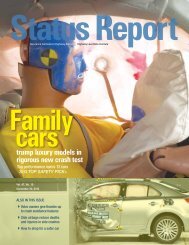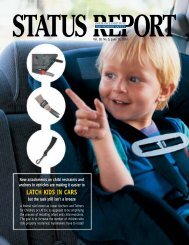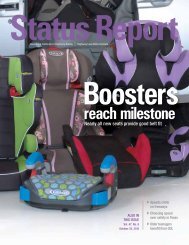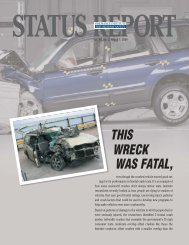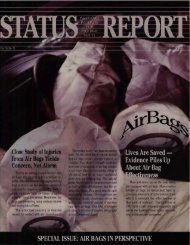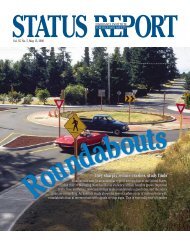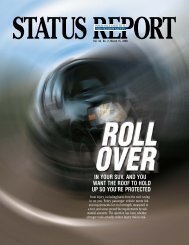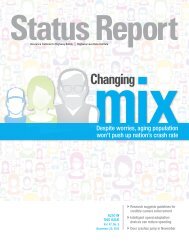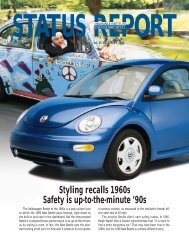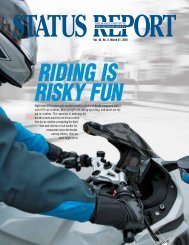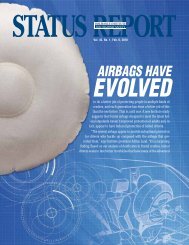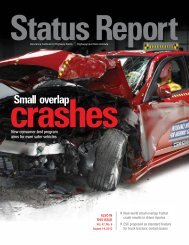Status Report, Vol. 46, No. 3 - Insurance Institute for Highway Safety
Status Report, Vol. 46, No. 3 - Insurance Institute for Highway Safety
Status Report, Vol. 46, No. 3 - Insurance Institute for Highway Safety
Create successful ePaper yourself
Turn your PDF publications into a flip-book with our unique Google optimized e-Paper software.
<strong>Vol</strong>. <strong>46</strong>, <strong>No</strong>. 3, March 30, 2011
2 <strong>Status</strong> <strong>Report</strong>, <strong>Vol</strong>. <strong>46</strong>, <strong>No</strong>. 3, March 30, 2011<br />
situations such technology should be equipped to handle. Researchers<br />
found the most common scenario involves a person<br />
crossing a roadway and a vehicle traveling straight. In most cases,<br />
nothing blocks the driver’s view of the pedestrian, and no braking<br />
is reported. Such crashes usually happen during the day, although<br />
most of the fatal ones occur at night.<br />
“The best way to protect pedestrians is to separate them as<br />
much as possible from vehicle traffic,” says David Zuby, the <strong>Institute</strong>’s<br />
chief research officer. “But the paths of walkers and drivers<br />
inevitably are going to intersect at some point, and new warning<br />
systems, as well as vehicle design changes required in Europe,<br />
have the potential to make those meetings less deadly.”<br />
Overall highway deaths have fallen to their lowest levels since<br />
1950, and much of the decline in recent years is due to safer vehicles.<br />
Pedestrian fatalities have fallen, too, but that may simply<br />
be a result of people walking less. Still the death toll remains high:<br />
In 2009, 4,092 pedestrians were killed, accounting <strong>for</strong> 12 percent<br />
of all crash fatalities in the United States.<br />
Tried and true methods <strong>for</strong> reducing pedestrian crashes generally<br />
involve roadway design changes. Pedestrians and vehicles<br />
can be separated with sidewalks, overpasses, and refuge islands<br />
Forward collision warning is offered<br />
on 19 vehicle makes in 2011<br />
and is one of several crash avoidance<br />
features that have been<br />
gaining ground. (Others are lane<br />
departure warning, side view assist,<br />
and adaptive headlights.) The<br />
<strong>Institute</strong> has estimated that as many<br />
as 1.2 million crashes, including 879<br />
fatal crashes, could be prevented or mitigated<br />
each year if all vehicles were equipped<br />
with <strong>for</strong>ward collision warning (see <strong>Status</strong><br />
<strong>Report</strong>, May 20, 2010; on the web at iihs.<br />
org). Pedestrian detection systems<br />
could prevent an additional 39,000<br />
crashes, including 2,932 fatal ones,<br />
researchers estimate.<br />
As automakers continue to<br />
work on this technology, the <strong>Institute</strong><br />
conducted its latest study<br />
to help guide their designs.<br />
the most common crash scenario<br />
involves a person crossing a road and<br />
a vehicle going straight. in most cases,<br />
nothing blocks the driver’s view of the<br />
pedestrian, and no braking is reported.<br />
in the middle of busy two-way streets. Better lighting and pedestrian<br />
countdown signals can help, as can reducing vehicle speeds<br />
and banning right turns on red. But such solutions haven’t always<br />
been implemented consistently and can’t address every risky scenario,<br />
which is why technology could play a key role.<br />
Crash avoidance technology: Systems aimed at preventing or<br />
lessening the severity of pedestrian crashes are an offshoot of a<br />
more common type of crash avoidance feature known as <strong>for</strong>ward<br />
collision warning. Such systems alert the driver if the vehicle is<br />
about to crash with a vehicle ahead of it and, in some cases, apply<br />
the brakes automatically if the driver fails to respond. A pedestrian<br />
detection system is a <strong>for</strong>ward collision warning system that<br />
has been enhanced to recognize not just vehicles, but people too.<br />
Looking at federal crash data from 2005-09,<br />
researchers found the vast majority of pedestrian<br />
crashes involved a single passenger<br />
vehicle, and most of those were<br />
frontal crashes. Ninety-five percent of<br />
people struck by the front of a vehicle<br />
and more than three-quarters of<br />
those who died were crossing<br />
traffic as opposed to walking<br />
along the road.<br />
Eight of 10 pedestrians<br />
who were killed<br />
while crossing traffic,
<strong>Status</strong> <strong>Report</strong>, <strong>Vol</strong>. 41, <strong>No</strong>. 3, March 30, 2011 3<br />
FATAL frontal crashes<br />
involving passenger vehicles and<br />
pedestrians, 2 most common scenarios<br />
All frontal crashes<br />
involving passenger vehicles and<br />
pedestrians, 2 most common scenarios<br />
60%<br />
60%<br />
60%<br />
40%<br />
40%<br />
40%<br />
20%<br />
20%<br />
20%<br />
d,<br />
g<br />
ual<br />
Pedestrian<br />
crossing road,<br />
vehicle turning,<br />
no visual<br />
obstruction<br />
Pedestrian<br />
crossing road,<br />
vehicle going<br />
straight, no visual<br />
obstruction<br />
Pedestrian<br />
moving in line<br />
with traffic,<br />
vehicle going<br />
straight, no<br />
visual obstruction<br />
Pedestrian<br />
crossing road,<br />
vehicle going<br />
straight, no visual<br />
obstruction<br />
Pedestrian<br />
crossing road,<br />
vehicle turning,<br />
no visual<br />
obstruction<br />
s<br />
as well as a majority<br />
of those<br />
who were struck<br />
but didn’t die, were<br />
hit by drivers who<br />
were going straight<br />
with no visual obstruction.<br />
That scenario accounted<br />
<strong>for</strong> a majority of all frontal<br />
collisions between passenger vehicles and<br />
pedestrians and 61 percent of the fatalities.<br />
Other kinds of crashes were far less common.<br />
The second most common one, involving<br />
a turning vehicle with no visual obstruction<br />
and a person crossing the road, accounted<br />
<strong>for</strong> about a quarter of pedestrians struck by<br />
the front of a vehicle and 4 percent of those<br />
who died. The second most common type of<br />
fatal crash, involving a vehicle going straight<br />
with no view obstruction and hitting a person<br />
walking in line with traffic, was responsible<br />
<strong>for</strong> 12 percent of pedestrian deaths.<br />
So-called dart-outs, in which a person appears<br />
suddenly in the roadway from behind<br />
a parked vehicle or other obstruction, were<br />
even less common.<br />
Of the cases involving vehicles going<br />
straight without view obstruction, drivers hit<br />
the brakes in only 13 percent of both fatal<br />
and nonfatal impacts. In other words, most<br />
drivers who hit pedestrians crossing the<br />
roadway apparently never react to what’s in<br />
front of them. That means pedestrian detection<br />
systems have a lot of potential to avert<br />
crashes by acting as an extra set of eyes and<br />
an extra foot above the brake pedal.<br />
Of course, a system that recognizes an<br />
impending collision only after the pedestrian<br />
is directly in front of (continues on p. 6)
4 <strong>Status</strong> <strong>Report</strong>, <strong>Vol</strong>. <strong>46</strong>, <strong>No</strong>. 3, March 30, 2011<br />
cars can brake<br />
<strong>for</strong> pedestrians<br />
if drivers don’t<br />
The developers of the first pedestrian collision<br />
mitigation system available in the United<br />
States drove about half a million miles in cities<br />
around the globe to gather the necessary in<strong>for</strong>mation<br />
about pedestrians — and about<br />
things a computer might mistake <strong>for</strong> them.<br />
“The most difficult part is actually to<br />
make sure that the car does not brake when<br />
it’s not supposed to,” says Thomas Broberg,<br />
senior technical adviser <strong>for</strong> safety at <strong>Vol</strong>vo.<br />
“You would never accept a car that brakes<br />
every time you pass a mailbox.”<br />
Introduced last year on the S60 sedan,<br />
<strong>Vol</strong>vo’s system, dubbed Pedestrian Detection,<br />
is now an option on several <strong>Vol</strong>vo models<br />
sold in the United States. The system<br />
uses radar combined with a camera to identify<br />
potential collisions with both pedestrians<br />
and the rear-ends of other vehicles and<br />
motorcycles. It first warns a driver of an impending<br />
crash and then brakes automatically<br />
if the driver doesn’t respond.<br />
Subaru has developed a similar system,<br />
but so far it’s only available in Japan. Other<br />
automakers are close behind. Audi, <strong>for</strong> example,<br />
is working on a system that, unlike<br />
<strong>Vol</strong>vo’s, promises to work in the dark. That’s<br />
important because most fatal pedestrian<br />
crashes take place at night.<br />
Automatic braking: In <strong>Vol</strong>vo’s system, if<br />
the driver isn’t taking action, a warning<br />
sounds and a red light meant to resemble<br />
another vehicle’s brake lights appears in the<br />
windshield. If the driver still doesn’t respond,<br />
the car stops itself. The Swedish automaker<br />
says the system can avoid a crash<br />
completely at speeds up to 22 mph. Beyond<br />
that, it’s about reducing the speed of the impact<br />
and, there<strong>for</strong>e, the consequences of<br />
the crash. The feature can function at<br />
speeds as fast as 50 mph.<br />
<strong>Vol</strong>vo estimates the feature could reduce<br />
by 24 percent pedestrian deaths caused by<br />
frontal crashes if it were adopted universally.<br />
In addition to being dependent on light,<br />
the <strong>Vol</strong>vo system has a few other limitations.<br />
It won’t spot a person shorter than<br />
31.5 inches or in a wheelchair, nor is it programmed<br />
to react to cyclists or animals. If a<br />
driver’s view of a pedestrian is blocked, the<br />
camera won’t be able to see the person either.<br />
However, it should work in what the<br />
<strong>Institute</strong> has identified as the most common<br />
scenario — a driver going straight with a<br />
clear view and a pedestrian crossing traffic.<br />
<strong>Vol</strong>vo suffered a few well-publicized failures<br />
during demonstrations <strong>for</strong> journalists.<br />
Video footage shows an S60 crashing into a<br />
dummy instead of stopping. Broberg says in<br />
the vast majority of demonstrations the system<br />
has worked as advertised, and the mishaps<br />
that did occur were a result of the
<strong>Status</strong> <strong>Report</strong>, <strong>Vol</strong>. <strong>46</strong>, <strong>No</strong>. 3, March 30, 2011 5<br />
<strong>Vol</strong>vo’s Pedestrian Detection uses radar<br />
and a camera to identify people who<br />
might end up in the car’s path (above and<br />
left). If the system determines a collision<br />
is imminent, it first alerts the driver with<br />
an audible warning and a red light in the<br />
windshield (far left). If the driver doesn’t<br />
respond, the vehicle brakes itself. The<br />
system also reacts to the rear-ends of<br />
other vehicles and motorcycles.<br />
technology’s sophistication. The system, he<br />
says, is “hard to trick” because it’s programmed<br />
to recognize only a flesh-andblood<br />
person.<br />
Pedestrian Detection is distinct from<br />
<strong>Vol</strong>vo’s City <strong>Safety</strong>, which uses a less expensive<br />
laser sensor and is aimed at avoiding<br />
rear-end crashes with other vehicles at low<br />
speeds only. Pedestrian Detection is an optional<br />
feature, raising the question of whether<br />
people are prepared to pay more to protect<br />
others. But the system also appeals to<br />
people’s self-interest because it prevents<br />
rear-end crashes with other vehicles and because<br />
it’s part of a bigger technology package<br />
that includes things like adaptive cruise<br />
control. The company estimates it will have<br />
a take rate of 20-25 percent globally.<br />
Broberg says <strong>Vol</strong>vo decided to do something<br />
about pedestrians because they account<br />
<strong>for</strong> such a large share of fatalities — 12<br />
percent in the United States and an even<br />
larger share in Europe. <strong>Vol</strong>vo and other automakers,<br />
spurred on by European regulators,<br />
have modified the fronts of vehicles to make<br />
them “softer” if they contact a pedestrian. It’s<br />
not clear yet how much such changes will<br />
help. Broberg, <strong>for</strong> his part, is skeptical.<br />
“Un<strong>for</strong>tunately, the laws of physics are<br />
against us there. … Two tons of steel versus<br />
80 kilograms of flesh,” he says. “So our belief<br />
has been that we need to try to help the<br />
drivers avoid these types of collisions.”<br />
What other manufacturers are doing:<br />
Subaru’s EyeSight system, which is available<br />
in Japan, is similar to <strong>Vol</strong>vo’s, but the<br />
latest version relies on two cameras to produce<br />
stereo vision, instead of radar and a<br />
single camera. The company says that helps<br />
keep down the cost.<br />
Subaru says its system can recognize<br />
both pedestrians and cyclists. As with <strong>Vol</strong>vo’s<br />
technology, EyeSight also is activated if<br />
the car gets too close to the vehicle in front<br />
of it and can brake automatically if the driver<br />
doesn’t respond to warnings.<br />
Audi, meanwhile, is working on a pedestrian<br />
avoidance system that it says will work<br />
in all light conditions. It uses a relatively<br />
new technology known as a PMD sensor, or<br />
photonic mixer device, to detect obstacles<br />
in the road. The system is designed to automatically<br />
brake if a crash with a pedestrian<br />
or large animal is unavoidable. It also avoids<br />
some collisions with other vehicles. The<br />
system is expected to reach consumers<br />
within the next three years.<br />
Audi already has a separate system that<br />
alerts drivers to the presence of pedestrians<br />
at night. The night vision assistant uses a<br />
thermal imaging camera to highlight people<br />
on a dashboard display.<br />
Both Mercedes and BMW have similar<br />
night vision features. BMW is developing a<br />
camera-based pedestrian detection system<br />
with automatic braking, and Mercedes is enhancing<br />
existing crash avoidance systems to<br />
react to pedestrians as well as other vehicles.
6 <strong>Status</strong> <strong>Report</strong>, <strong>Vol</strong>. 41, <strong>No</strong>. 3, March 30, 2011<br />
mph, and over 49 mph each accounted <strong>for</strong><br />
more than a quarter of them.<br />
The biggest hurdle <strong>for</strong> the new technology<br />
is how to prevent crashes that occur at<br />
night. The systems on the market now rely<br />
on light-dependent cameras. Most frontal<br />
collisions with pedestrians occur during the<br />
day, so these systems could be expected to<br />
take a bite out of the overall pedestrian<br />
crash problem. But with more than twopredicting<br />
when<br />
a pedestrian will<br />
cross a vehicle’s<br />
path is a crucial<br />
design issue <strong>for</strong><br />
any new system.<br />
(continued from p. 3) the vehicle would<br />
hold limited value. The trick is developing<br />
technology that can accurately predict<br />
when someone is going to step into the path<br />
of a vehicle.<br />
“Pedestrians can change course quickly,<br />
so just as it can be hard <strong>for</strong> a driver to know<br />
what a person at the curb is going to do, it<br />
also can be tricky <strong>for</strong> a computer,” Zuby<br />
says. “It’s important to get that right because<br />
too many false alarms could turn a<br />
warning system into an annoyance and<br />
make drivers reluctant to accept the new<br />
technology.”<br />
Another finding relevant to developers of<br />
pedestrian detection systems is that threequarters<br />
of people struck were on roads<br />
with speed limits of less than 40 mph. Fatalities,<br />
however, were more evenly distributed.<br />
Roads with speed limits of 30-39 mph, 40-49
<strong>Status</strong> <strong>Report</strong>, <strong>Vol</strong>. <strong>46</strong>, <strong>No</strong>. 3, March 30, 2011 7<br />
thirds of fatalities occurring after dark, significantly<br />
cutting pedestrian deaths will require<br />
technology that can per<strong>for</strong>m reliably<br />
with limited or no light.<br />
Europe’s approach: Crash avoidance<br />
technology is just one aspect of the ef<strong>for</strong>t to<br />
improve passenger vehicles to protect pedestrians.<br />
Another strategy is to modify the fronts<br />
of vehicles to lessen the harm they can cause<br />
to a person who is struck. New regulations<br />
in the European Union are taking this route.<br />
As of September 2010, all passenger vehicles<br />
must pass crash tests that assess the<br />
risk of injury to an adult’s head, a child’s<br />
head, and adult’s knee and lower leg. By<br />
September 2015, automakers must comply<br />
with a second phase that has stricter standards<br />
<strong>for</strong> the head and leg and also tests the<br />
impact that the hood’s edge would have on<br />
a person’s hip.<br />
To meet the new requirements, automakers<br />
are putting more room between the<br />
hood and engine, designing hoods that automatically<br />
raise up a few inches from the engine<br />
upon impact, installing hood airbags,<br />
hiding hard elements like windshield wipers,<br />
and designing softer bumpers <strong>for</strong> their<br />
vehicles sold in Europe. It’s too soon to tell<br />
whether these changes are reducing pedestrian<br />
injuries.<br />
In the United States, the National <strong>Highway</strong><br />
Traffic <strong>Safety</strong> Administration conducted<br />
research from the 1970s through the early<br />
1990s that could have led to similar requirements,<br />
but that ef<strong>for</strong>t was scuttled (see <strong>Status</strong><br />
<strong>Report</strong>, March 13, 1999). The agency<br />
never made clear its reasons <strong>for</strong> abandoning<br />
the idea, but the motivation <strong>for</strong> it likely<br />
faded as pedestrian fatalities continued to<br />
drop on their own.<br />
Nevertheless, some version of the European<br />
tests may come to the US in the future<br />
as part of an ef<strong>for</strong>t to standardize such regulations<br />
across the globe.<br />
For a copy of “Primary pedestrian crash<br />
scenarios: factors relevant to the design of<br />
pedestrian detection systems” by J.S. Jermakian<br />
and D. Zuby, write: Publications, <strong>Insurance</strong><br />
<strong>Institute</strong> <strong>for</strong> <strong>Highway</strong> <strong>Safety</strong>, 1005 N.<br />
Glebe Rd., Arlington, Va. 22201, or email<br />
publications@iihs.org.<br />
SILENCE ISN’T GOLDEN WHEN IT<br />
COMES TO hybrids, electrics<br />
The National <strong>Highway</strong> Traffic <strong>Safety</strong> Administration has three years to come up with a requirement<br />
<strong>for</strong> equipping quiet hybrid and electric vehicles with sounds so that pedestrians can hear<br />
them coming. President Barack Obama signed the bill setting the deadline in January.<br />
With the proliferation of hybrids, advocates <strong>for</strong> the blind have raised concerns that the<br />
vehicles don’t produce enough noise to warn pedestrians, particularly at low speeds when<br />
they are likely to be operating solely on electricity. Quiet vehicles are a concern not only <strong>for</strong><br />
the blind, but <strong>for</strong> anybody traveling on foot or bicycle. A 2009 government study found hybrids<br />
are more likely to crash with pedestrians and bicyclists than vehicles with internal combustion<br />
engines (see <strong>Status</strong> <strong>Report</strong>, Dec. 22, 2009; on the web at iihs.org).<br />
US Secretary of Transportation Ray LaHood said in a recent blog post that government researchers<br />
have begun testing synthetic sounds in advance of the new law. “We’re trying to find<br />
the right balance between quiet roadways and pedestrian safety,” he wrote. Automakers also<br />
are trying to get in front of the issue. The electric Nissan Leaf produces an airplane-like<br />
whooshing sound at low speeds, as does the M35 hybrid from Nissan’s Infiniti brand. The<br />
Chevrolet <strong>Vol</strong>t can emit a chirping sound along with flashing lights, but drivers have<br />
to activate the alert system. Another example is the Hyundai Sonata<br />
hybrid, which makes a sound similar to a gently accelerating<br />
gasoline engine.<br />
OESCH RETIRES FROM INSTITUTE<br />
Stephen L. Oesch has retired after 29 years with the <strong>Institute</strong>. He began his <strong>Institute</strong> career as<br />
a communications researcher tracking down background in<strong>for</strong>mation <strong>for</strong> <strong>Status</strong> <strong>Report</strong> articles<br />
and retired as secretary-treasurer and senior vice president <strong>for</strong> insurer and government relations<br />
in December 2010.<br />
Oesch worked on a variety of highway loss reduction programs. These included <strong>Institute</strong><br />
ef<strong>for</strong>ts to improve federal safety standards <strong>for</strong> motor vehicles and implement effective traffic<br />
laws and en<strong>for</strong>cement programs to reduce alcohol-impaired driving and increase child restraint<br />
and safety belt use.
1005 N. Glebe Rd., Arlington, VA 22201<br />
Phone 703/247-1500 Fax 247-1588<br />
Internet: www.iihs.org<br />
<strong>Vol</strong>. <strong>46</strong>, <strong>No</strong>. 3, March 30, 2011<br />
Pedestrians stand to benefit from new<br />
vehicle technology and design changes<br />
aimed at preventing crashes ................1<br />
<strong>Vol</strong>vo brings the first pedestrian avoidance<br />
system to US market ...................4<br />
Quiet electric and hybrid vehicles to<br />
get noise requirement ..........................7<br />
Stephen L. Oesch retires ......................7<br />
Contents may be republished with attribution.<br />
This publication is printed on recycled paper.<br />
The <strong>Insurance</strong> <strong>Institute</strong> <strong>for</strong> <strong>Highway</strong> <strong>Safety</strong> is a<br />
nonprofit scientific and educational organization<br />
dedicated to reducing deaths, injuries, and property<br />
damage from crashes on the nation’s highways.<br />
The <strong>Institute</strong> is wholly supported by auto insurers:<br />
AAA <strong>No</strong>rthern Cali<strong>for</strong>nia, Nevada, and Utah<br />
ACE Private Risk Services<br />
Affirmative <strong>Insurance</strong><br />
Agency <strong>Insurance</strong> Company of Maryland<br />
Alfa Alliance <strong>Insurance</strong> Corporation<br />
Alfa <strong>Insurance</strong><br />
Allstate <strong>Insurance</strong> Group<br />
American Family Mutual <strong>Insurance</strong><br />
American National Property and Casualty Company<br />
Ameriprise Auto & Home<br />
Amica Mutual <strong>Insurance</strong> Company<br />
Auto Club Enterprises<br />
Auto Club Group<br />
Bituminous <strong>Insurance</strong> Companies<br />
Cali<strong>for</strong>nia Casualty Group<br />
Capital <strong>Insurance</strong> Group<br />
Chubb & Son<br />
Colorado Farm Bureau Mutual <strong>Insurance</strong> Company<br />
Concord Group <strong>Insurance</strong> Companies<br />
Cotton States <strong>Insurance</strong><br />
COUNTRY Financial<br />
Direct General Corporation<br />
Discovery <strong>Insurance</strong> Company<br />
Erie <strong>Insurance</strong> Group<br />
Esurance<br />
Farm Bureau Financial Services<br />
Farm Bureau <strong>Insurance</strong> of Michigan<br />
Farm Bureau Mutual <strong>Insurance</strong> Company of Idaho<br />
Farmers <strong>Insurance</strong> Group of Companies<br />
Farmers Mutual of Nebraska<br />
Fireman’s Fund <strong>Insurance</strong> Company<br />
First Acceptance Corporation<br />
Florida Farm Bureau <strong>Insurance</strong> Companies<br />
Frankenmuth <strong>Insurance</strong><br />
Gainsco <strong>Insurance</strong><br />
GEICO Group<br />
Georgia Farm Bureau Mutual <strong>Insurance</strong> Company<br />
GMAC Personal Lines <strong>Insurance</strong><br />
Grange <strong>Insurance</strong><br />
Hallmark <strong>Insurance</strong> Company<br />
Hanover <strong>Insurance</strong> Group<br />
The Hart<strong>for</strong>d<br />
Haulers <strong>Insurance</strong> Company, Inc.<br />
High Point <strong>Insurance</strong> Group<br />
Homeowners of America <strong>Insurance</strong> Company<br />
Horace Mann <strong>Insurance</strong> Companies<br />
ICW Group<br />
Imperial Fire & Casualty <strong>Insurance</strong> Company<br />
Infinity Property & Casualty<br />
Kemper, A Unitrin Business<br />
Kentucky Farm Bureau <strong>Insurance</strong><br />
Liberty Mutual <strong>Insurance</strong> Company<br />
Louisiana Farm Bureau Mutual <strong>Insurance</strong> Company<br />
Mercury <strong>Insurance</strong> Group<br />
MetLife Auto & Home<br />
MiddleOak<br />
Mississippi Farm Bureau Casualty <strong>Insurance</strong> Company<br />
MMG <strong>Insurance</strong><br />
Mutual of Enumclaw <strong>Insurance</strong> Company<br />
Nationwide<br />
New Jersey Manufacturers <strong>Insurance</strong> Group<br />
NLC <strong>Insurance</strong> Companies, Inc.<br />
<strong>No</strong>dak Mutual <strong>Insurance</strong> Company<br />
<strong>No</strong>rfolk & Dedham Group<br />
<strong>No</strong>rth Carolina Farm Bureau Mutual <strong>Insurance</strong> Company<br />
Oklahoma Farm Bureau Mutual <strong>Insurance</strong> Company<br />
Old American County Mutual Fire <strong>Insurance</strong><br />
Oregon Mutual <strong>Insurance</strong><br />
Palisades <strong>Insurance</strong><br />
Pekin <strong>Insurance</strong><br />
PEMCO <strong>Insurance</strong><br />
Progressive Corporation<br />
Rockingham Group<br />
Safeco <strong>Insurance</strong><br />
Samsung Fire & Marine <strong>Insurance</strong> Company<br />
SECURA <strong>Insurance</strong><br />
Sentry <strong>Insurance</strong><br />
Shelter <strong>Insurance</strong><br />
Sompo Japan <strong>Insurance</strong> Company of America<br />
South Carolina Farm Bureau Mutual <strong>Insurance</strong> Company<br />
Southern Farm Bureau Casualty <strong>Insurance</strong> Company<br />
State Auto <strong>Insurance</strong> Companies<br />
State Farm<br />
Tennessee Farmers Mutual <strong>Insurance</strong> Company<br />
Texas Farm Bureau <strong>Insurance</strong> Companies<br />
Tokio Marine Nichido<br />
The Travelers Companies<br />
United Educators<br />
Unitrin<br />
USAA<br />
Viceroy <strong>Insurance</strong> Company<br />
Virginia Farm Bureau Mutual <strong>Insurance</strong><br />
West Bend Mutual <strong>Insurance</strong> Company<br />
Young America <strong>Insurance</strong> Company<br />
Zurich <strong>No</strong>rth America<br />
FUNDING ASSOCIATIONS<br />
American <strong>Insurance</strong> Association<br />
National Association of Mutual <strong>Insurance</strong> Companies<br />
Property Casualty Insurers Association of America



